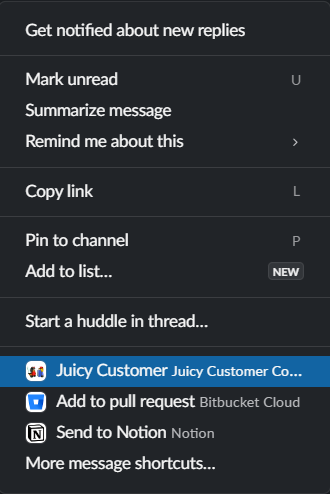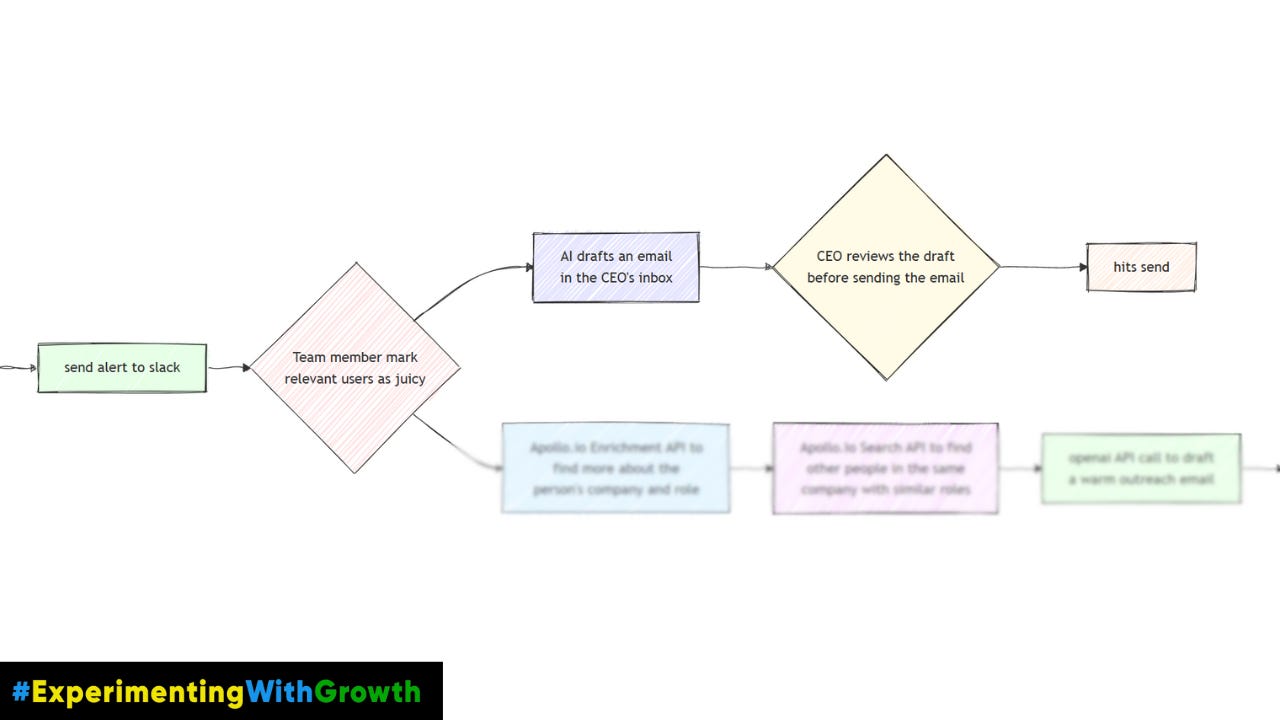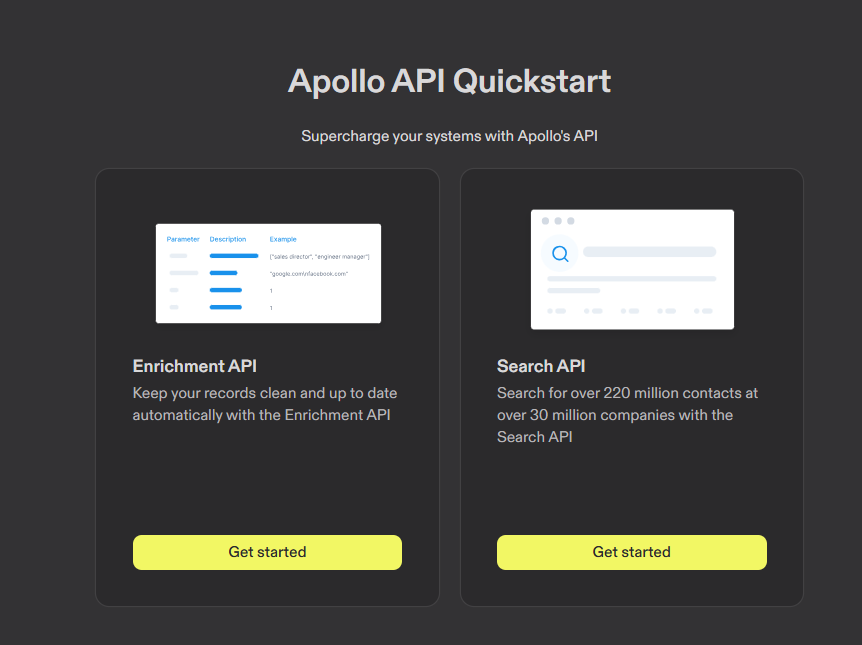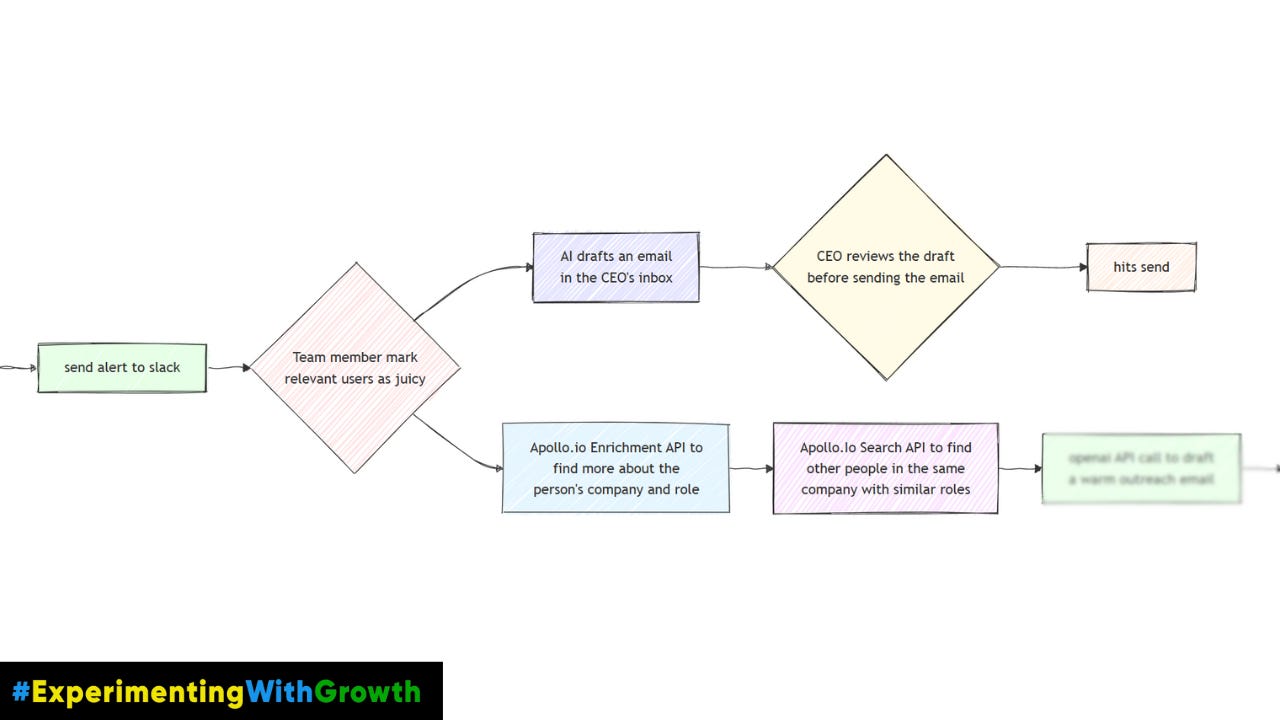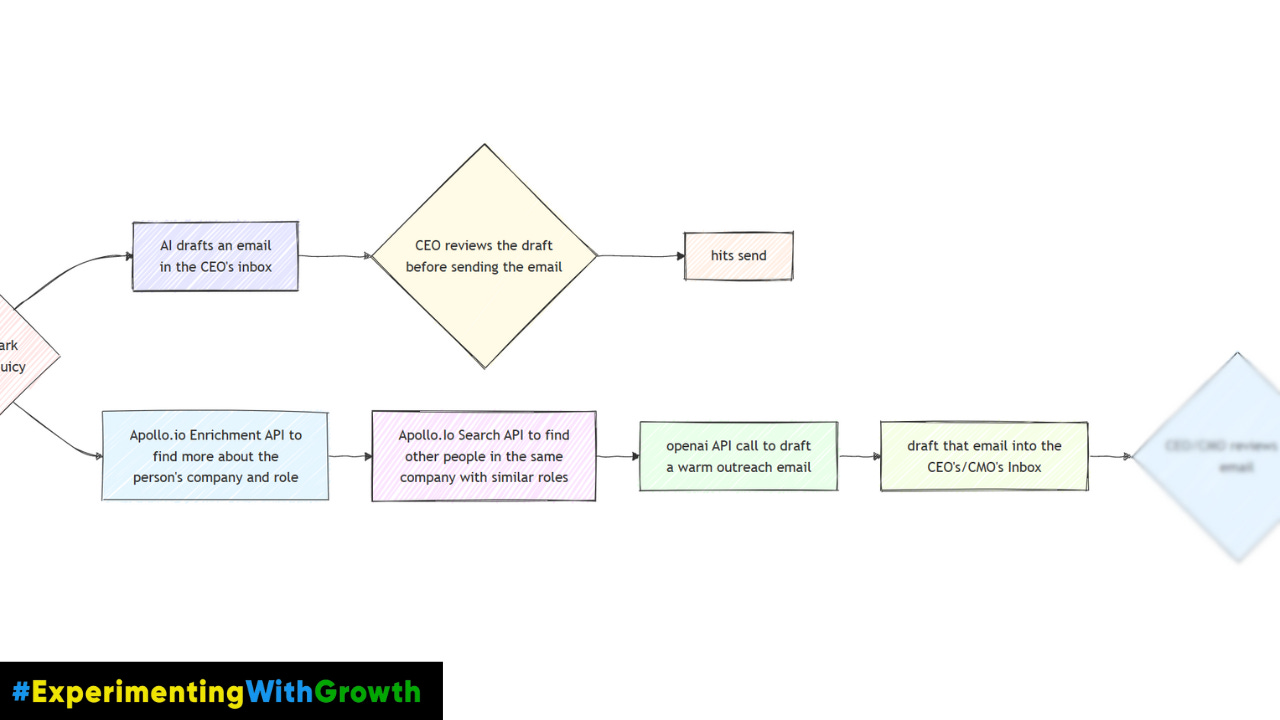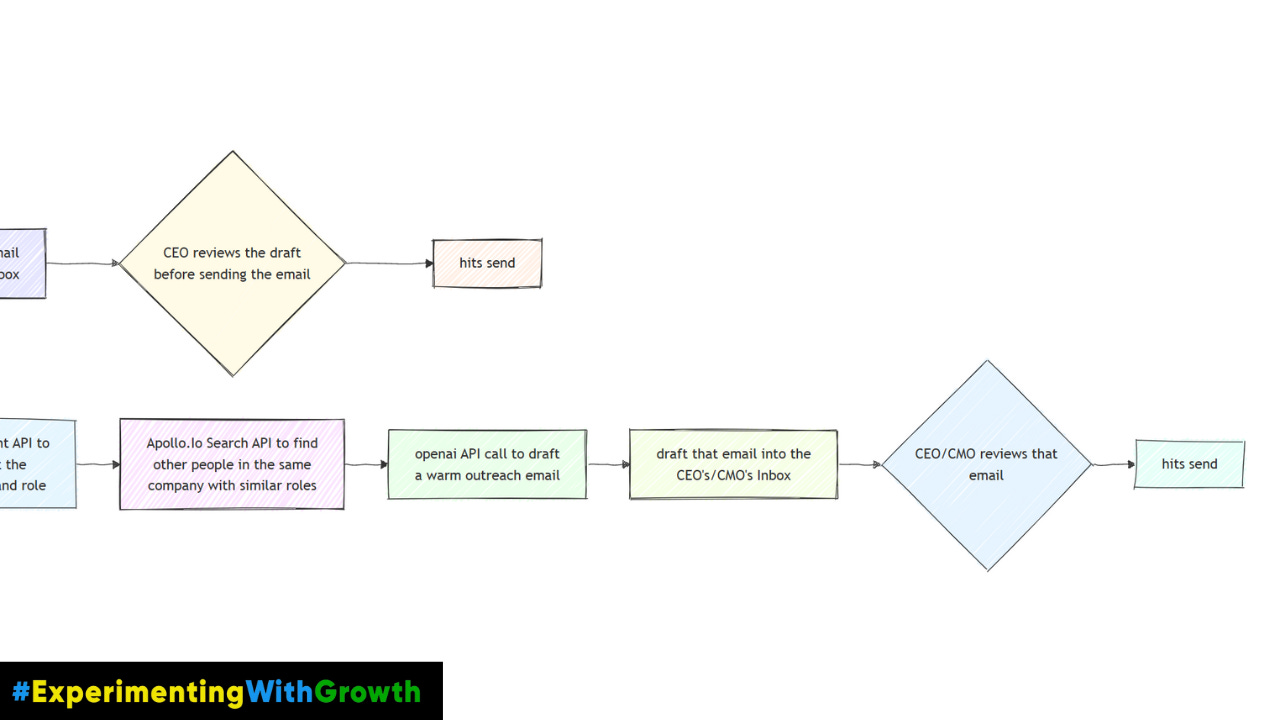Growth experiment that turned inbound sign-ups into high-ticket deals
The Juicy Customer Workflow: How We Turned Random Inbound Sign-ups into High-Ticket Deals
Do you check every day who signed up for your product and think, “this could be big”… then life happened, and nothing followed?
We had a similar story, then I experimented with a GTM workflow that turned casual inbound signups into a reliable high-ticket pipeline.
This is the story (and the exact playbook) of how we at my current company took a boring “new user signed up” alert and turned it into a compound growth loop: identify the big fish early, make them feel like VIPs, and quietly expand inside their org, that too without running a single cold campaign or burning money on ads.
Tools Needed: n8n, Slack(dev), Apollo.io, LinkedIn, Any CRM(with dev access)The Problem Behind “Good” Inbound
The idea is to eyeball every person who signs up for your app. Look at the onboarding data they entered, and look at their email. By the look of it, do you think this can be a big-ticket client? because this whole workflow depends on it. Let me give you an example.
Suppose that john.doe@pepsico.com signed up for your product, and in the onboarding questions, they told you that they want to use your product for Sales Enablement Training.
We will keep this example for the rest of the blog.
The System: Spot → Signal → Strike
Step 1: Make Every Signup Visible (and Scannable)
We send every signup to a Slack channel as an alert. Nothing fancy, just a message with:
Name + Email
UTM / source
Intended use case (if captured)
Plan (trial/free/paid)
Link to user profile / CRM record
Why Slack? Because attention ≈ time-to-touch. If it’s in Slack, it’s in the team’s bloodstream. And our whole team is on Slack 24/7, which means every person on our team is “the-human-in-loop”.
UI we use in Slack (example):
New signup 🎉
• Name: John Doe
• Email: john.doe@pepsico.com
• Source: Organic homepage
• Plan: Free trial
• Use case: “Running polls in monthly training”
[Open in CRM] [View in app]Step 2: Tag the “Juicy” Ones in One Click
Inside that Slack message, we added an action: “Mark as Juicy”. This step of the workflow is set up via Slack Developer Console. You can watch this YouTube video to understand how to create a Slack App with an action.
Juicy criteria (simple, fast, human-friendly):
Recognizable/large org domain (Fortune, unicorns, mid-market with 200+ headcount). → Essentially, anyone with a company domain that has the money to pay you a substantial amount.
Use cases with org-wide resonance → During the onboarding, you have to ask them questions similar to “How are you going to use [Your Product]”. You can be very direct about it, or you can make this question subtle.
When any member of our team clicks Mark as Juicy for a user signup, we attach a tag in CRM, add a “VIP” label in our data warehouse, and, crucially, trigger the next steps.
This process can be entirely automated with n8n and apolloAPI. Here's how you can do it:
-> When a user signs up, run their email through a regex to mark email with generic domains like gmail.com, proton.me, etc.
-> For users who have a non-generic email domain, send their domain URL to the Apollo.io search API and fetch the details of the company.
-> Apollo.io gives you a ton of detail about that company, which you can use to filter out if a company is juicy or not.
-> For example, if a company has 100+ employees, then it can be juicy. Or if a company has 1M+ funding or 1M+ revenue, then it can be marked as juicy.
-> You're basically only limited by your imagination here.
Step 3: A Real Email from the CEO (Not “From: Marketing”)
Seconds after tagging, an AI-written email (based on the onboarding details of the user and the company data we fetched from Apollo) gets drafted in the inbox of the CEO, and the CEO gets a notification to check that email. This part of the workflow is handled by n8n (+ Google Workspace).
Then the CEO reviews the email, humanises it to an extent, adds his personal touch, and hits send.
The prospect gets a short, human email from the CEO’s actual inbox. Not a “noreply”, not “via ESP”, the real account.
Subject: Quick hello, welcome to [Your Company]
Body (template):
Hey {{first_name}} — I noticed you just signed up from {{company}}.
I’m {{ceo_first_name}}, one of the founders. If you’re exploring [Your product] for {{stated_use_case | “your sessions”}}, I can help you shortcut setup:
• {usecase 1}
• {usecase 2}
here's a 2-minute setup loom, or let me know if you want me to hop of a 15-min call to guide you through the product.
— {{ceo_first_name}}
This works because it collapses the distance between the curious user and the executive sponsor. It signals importance, lowers risk, and unlocks conversations that “sales@” never will.
Step 4: Search for Same Role Same Company
This is where the crazy part begins.
We use the Apollo.io enrichment API to search for the user who signed up (for ease, let’s call this user the original user)
The idea behind this is to learn more about who this person is and what their role is at the company (remember, we already know their use case for using our product, as we asked them that during the onboarding).
Then we make another call to the apollo.io search API for the company domain (eg, pepsico.com) and the job title (eg, Sales Enablement).
Since the company is really big, there is always more than one person in a role. And we get around 10 to 100 people in the company with a similar title and similar seniority who will also have the same use case for our product as the original user.
Step 5: Warm Expansion Inside the Same Company
Now, we expand sideways while the iron is warm.
We send a respectful, context-rich note. This note can be sent either from the CEO or the head of marketing. Just don’t use the main email of either. Use a secondary email that is only used for this purpose.
For every company, create one unique email. And use AI (or straightforward personalization) to draft the email in your (CEO’s, CMO’s) inbox. Never send the email created by AI without reviewing it first.
Here’s an example.
Subject: Your teammate is trying [your product] for {{usecase}}
Body (template):
Hey {{peer_first_name}} — quick heads up from [your company].
Many users with similar role as you from {{dept_or_team}} team started testing [product x] to make {{usecase entered by original user}} more [benefit/features] (eg: live polls, magic maps, Q&A, word clouds inside PowerPoint/Zoom).
If you run similar sessions, this 90-second loom shows how they’re setting it up: {{personalized_loom_link}}.
Happy to bundle you and your teamamtes into one quick walkthrough so you can share a template and skip the trial-and-error.
Worth a look?
— {{sender_first_name}}, [your company]
Important Note: This email is very sensitive. If not sent or crafted clearly, it can look creepy very fast. So make sure you get this email reviewed by your CEO and CMO. For this email, there is a very fine line between serendipitous and cynical.
Guardrails:
If it doesn’t make sense, don’t reveal the name of the original user in this email.
Never imply endorsement, only that a colleague is exploring.
Include one small, concrete benefit tied to their function.
Offer a shared setup to nudge internal alignment.
Step 6: Human-in-the-Loop quality check.
AI drafts the variations; a human owner (CEO/marketing) approves in 60–120 seconds.
QA checklist (60 seconds):
✅ Would I send this to a friend at a FAANG? (tone check)
✅ No over-promising, no “we’re the best” fluff
✅ 1 CTA, 1 link, short paragraphing
✅ Accurate role/use-case/company
Check if the drafted email is send-worthy and then hit send. You can also add follow-up emails after this email, in case no one replies.
Apollo.io also gives you the LinkedIn profile URL of the person. You can send a connection request, followed by a DM to each person. You can use relay.app to automate that process as well. This will give you multiple touch points with the person. Just make sure that when sending a message and a connection request, everything is conversational and not promotional.
Step 7: Reach out to the decision makers.
More often than not, the folks signing up (the original user + their peers) aren’t the budget holders.
Once you see 5+ people from the same company and function spinning it up, escalate. Manually reach out to the team lead/VP who actually owns the budget and say, in plain words: “A bunch of your team is already using {product}. Let’s standardize this with an annual contract so it’s easier for everyone.”
Then spell out the benefits: single invoice, SSO/admin controls, shared templates, priority support, one-time security review, and volume pricing.
This last step will turn scattered usage into an executive-level “YES”.
That’s the Juicy Customer Workflow. Steal it, ship it, and tell me what breaks; I’ll help you tune it.
Here’s the full funnel if you want to share it on LinkedIn:




